Stinging Nettle – One of Most Useful Wild Plants
This post may contain affiliate links. Read my full disclosure here.
Don’t let the “sting” of stinging nettles keep you from getting to know this amazing plant. Nettles have a long history of use for food, medicine, fiber and more. We’ll introduce you to this natural green wonder and its many benefits.
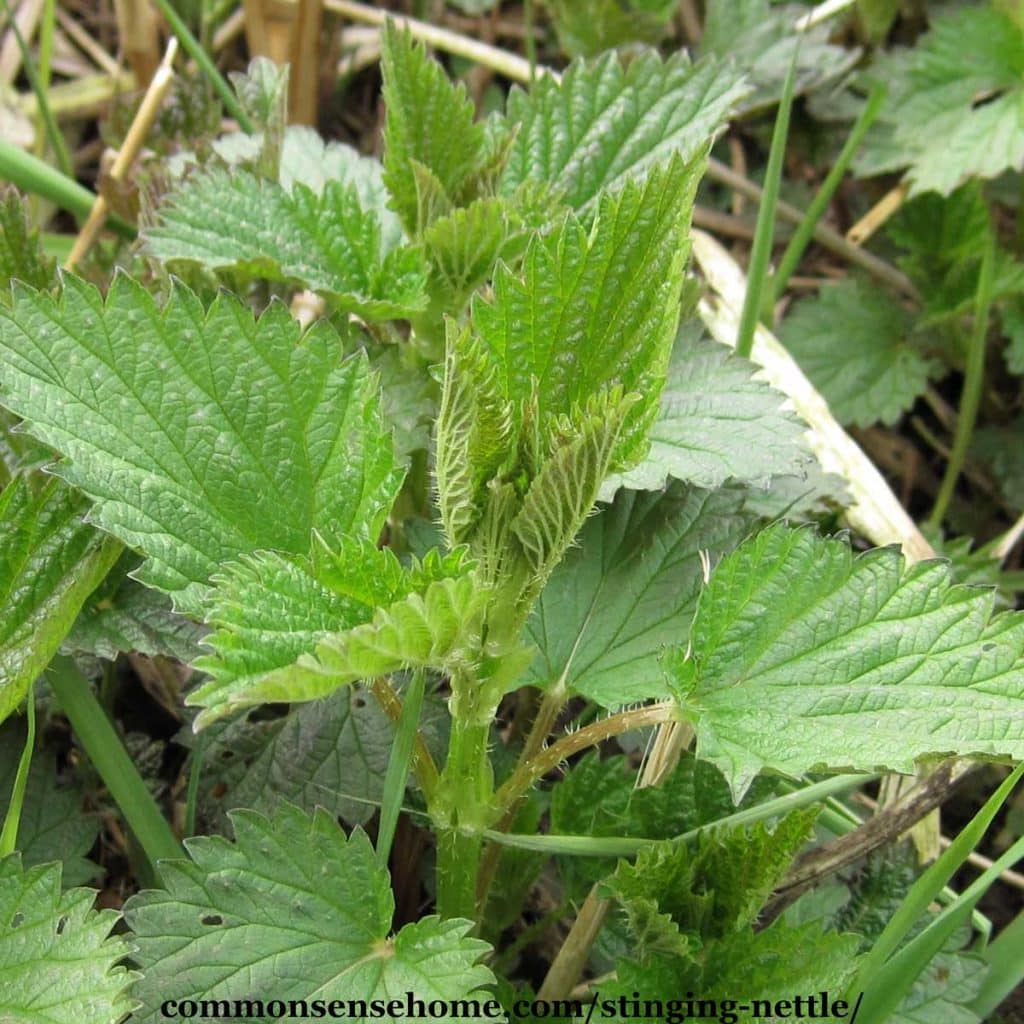
Stinging Nettle, Urtica dioica
Stinging nettle is also known as common, slender or tall nettle; stingers, wild spinach, and devil leaf.
Where to Find Stinging Nettle
Nettles are a perennial plant found in the United States, Canada, Europe, Asia, Africa and South America. They prefer high nitrogen soil with plenty of moisture, like the edges of farm fields and along rivers.
If they show up in your garden, you might want to relocate them before the plants get too big. They spread via rhizomes, and can take over a garden bed completely. Planted along an edge they can protect your garden, but be wary of spreading.
If you don’t have your own stinging nettles to gather, there are a wide variety of nettle products on the market. Health food stores, online merchants and enterprising herbalists sell everything from herbal tea, to salves to freeze dried nettles.
Plant Identification – Leaves, Stems and Roots
The mature leaves are oblong and deeply toothed. They are 2-5 inches long and found in opposite pairs every few inches along the upper half of the stalk. Young plants will often have a purplish tinge as they emerge from the ground.
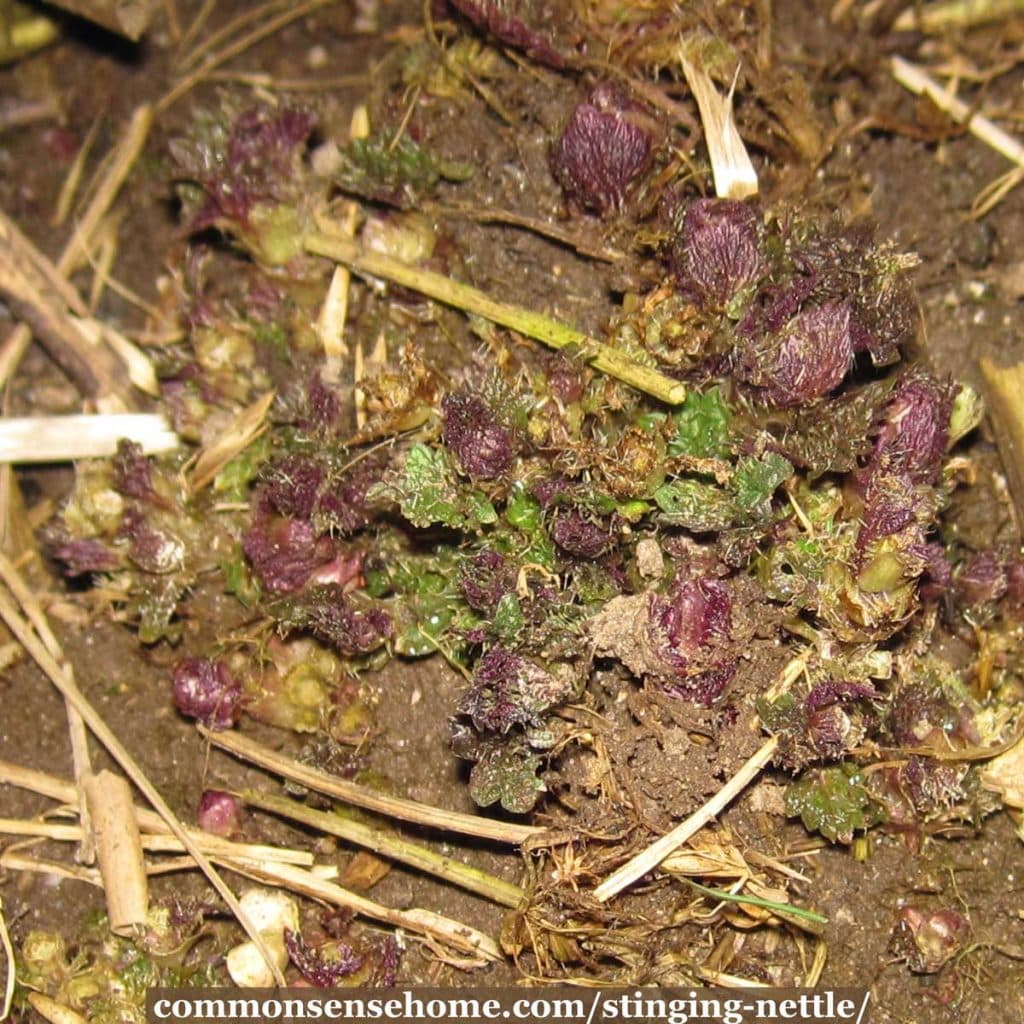
The entire plant is covered with fine stinging hairs and grows from 3-7 feet tall in temperate climates. (Warm climate Urtica dioica can grow up to 20 feet tall.) Stalks are hollow and squarish, with four deep grooves running along their length.
The stem contains strong fibers, historically used for rope, fabric and paper. (More on this below.)
Nettle roots form rhizome networks, similar to quackgrass. A healthy colony can spread five feet or more in a season.
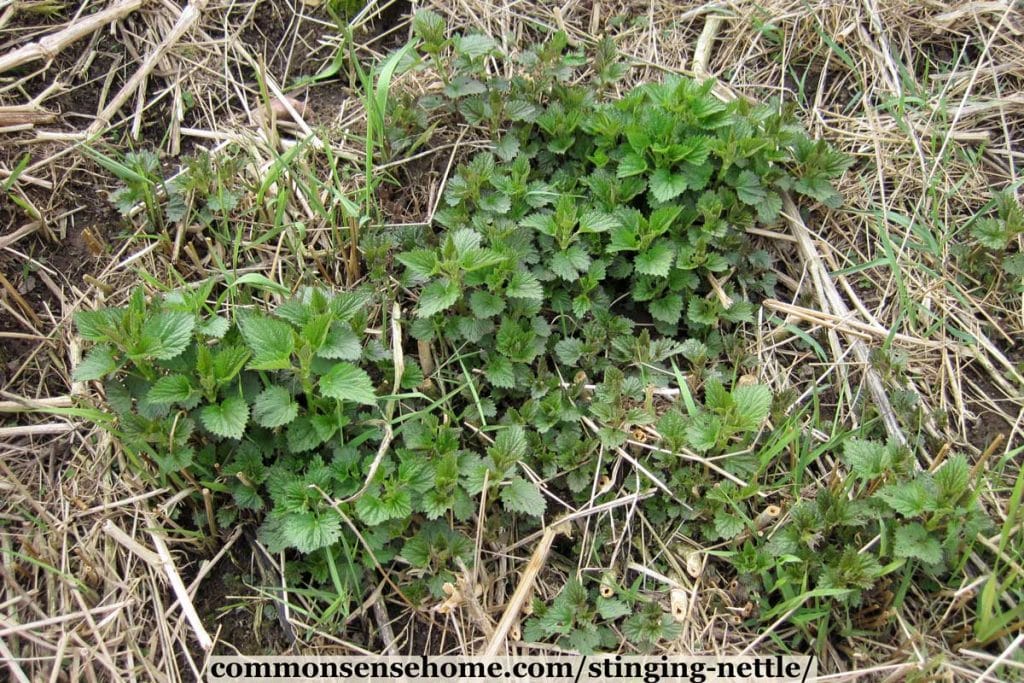
Stinging Nettle Rash
Touching a nettle plant with bare skin will produce a stinging or burning sensation. Each stinging hair contains toxin at the base. When you brush against the plant, the tip of the hair breaks off. This broken hair acts like a hypodermic needle to inject formic acid (also found in ant bites), histamine, acetylcholine and other irritants.
The rash will subside on its own over time. To speed up the process, try applying crushed plantain, jewelweed, dock, rosemary, mint or sage. If you don’t have herbs available, boil and cool a cabbage leaf for a poultice. Antihistamines may also help.
Some people use toothpaste as a home remedy for nettle sting, but there’s not much evidence to back that option up.
Can you die from nettle stings?
Not likely, unless you have a severe allergic reaction, but it’s best to limit exposure until you see how your body reacts. Some people are more sensitive than others. Don’t confuse the sting from nettles with phytophotodermatitis.
Eating Stinging Nettles
Harvest fresh nettle tops in spring to use in cooking, or keep the plants cut back and harvest fresh growth throughout the season. Use gloves, or handle with care.
Use nettle as you would any cooked green. They are rich in vitamins and minerals, including vitamins C and A; calcium, potassium, magnesium and iron. Nettles are also very high in protein.
Do not eat the leaves raw or undercooked. Heat neutralizes the sting, but sensitive individuals may still not tolerate them well. Blanch for two minutes, sauté or steam.
I did not react to a dried leaf infusion. I did react to fresh leaf infusion. Nothing serious, but I’ll make sure to thoroughly cook or dry my nettles before consuming them in the future.
Nettles may also be dehydrated for later use. Rinse leaves (if needed) and pat dry. Dehydrate at low temps. (95°F in a commercial dehydrator, or air dry.)
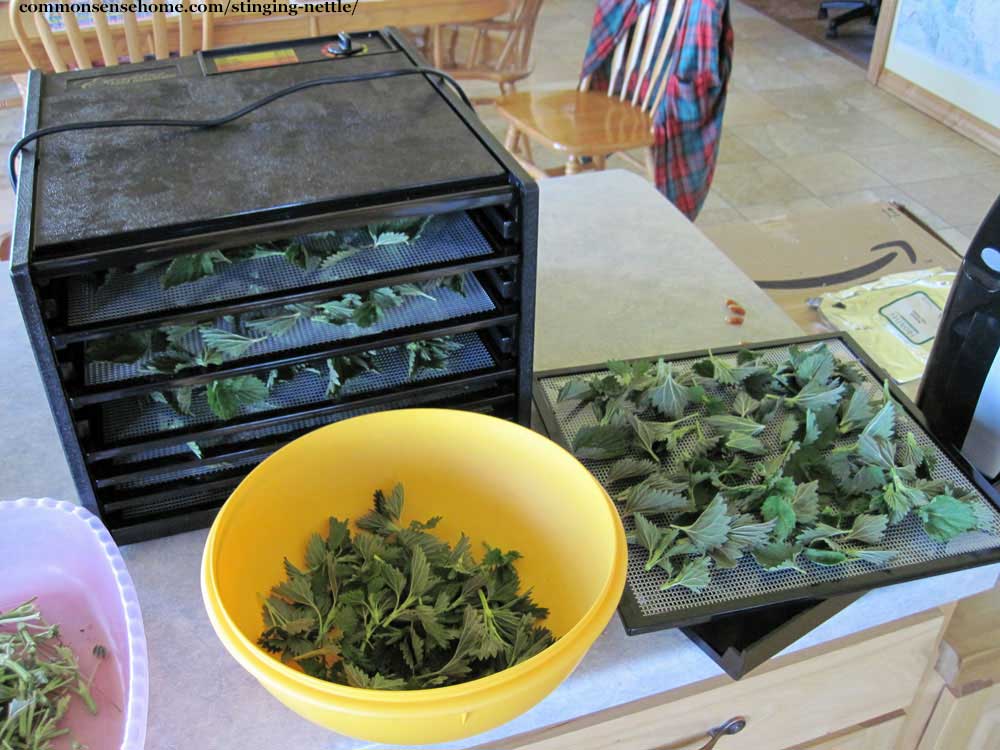
Like all edible wild plants, be careful to make sure to clearly identify the plant and test a little at first before consuming in quantity
Note: Healing Wise (Wise Woman Herbal Series)Healing Wise has a very nice assortment of nettle recipes for food and for hair and skin tonics.The Forager’s Harvest is another good resource for harvesting and cooking tips.
Stinging nettles play host to a wide variety of insects and provide food for many other critters. They are the only food source for the larval form of the red admiral butterfly.
When I was a little girl, my mom would always add some chopped leaves and sour milk to cow feed to feed to the baby ducks and geese.
Nettles as a Herbal Rennet Substitute for Making Cheese
You can use nettles and some other herbs as a rennet substitute in cheesemaking. (The book Stillroom Cookery: The Art of Preserving Foods Naturally, With Recipes, Menus, and Metric MeasuresStillroom Cookery mentions cleavers and Jerusalem artichoke as other options as well.) Susun Weed gives a recipe for herbal rennet in Healing Wise:
- 1 quart nettles and 1 quart water
- 1 teaspoon salt
Cook leaves in simmering salted water in well-covered pan for ten minutes. Strain and add to warm milk. (Each cup of this will curdle 4 quarts (1 gallon) of milk.)
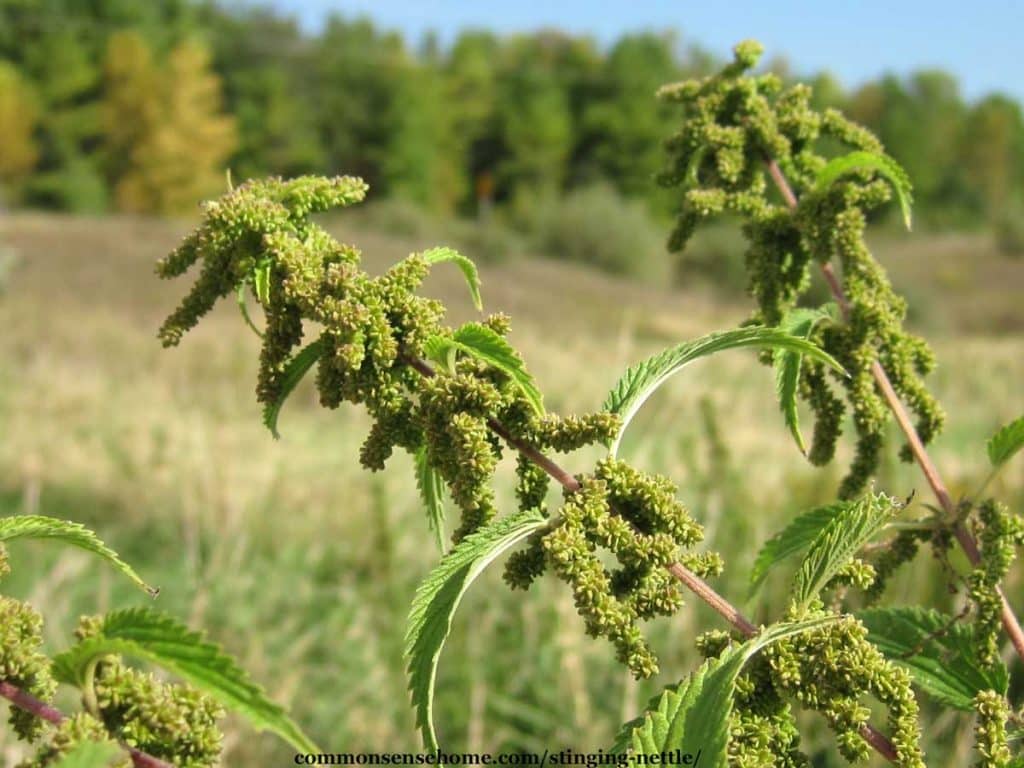
Stinging Nettle Benefits
In Healing Wise (Wise Woman Herbal Series)Healing Wise, Susun Weed sings the praises of nettle for just about everything, lauding it as a hair and skin tonic, adrenal booster, bone builder, gout healer and more. It acts as an anti inflammatory, and is loaded with nutrients.
Treat Seasonal Allergies
Using capsules or tea leading up to and through allergy season may help to reduce seasonal allergy symptoms, including allergic rhinitis.
Would you like to save this?
Arthritis and Joint Pain
Historically, nettle arthritis treatment includes oral use and urtication. Urtication means flailing the affected joints with the plant. Read more in the post, “Home Remedies for Arthritis“.
Helps Regulate Blood Sugar
Nettle leaves were used traditionally to help treat diabetes mellitus, and modern studies indicate that they may help type 2 diabetic patients improve glycemic control.
Prevent and Break Down Kidney Stones
Nettle has a long history of use for urinary tract health. Initial studies indicate that the bioactive phytochemicals in the plant may inhibit calcium and oxalate deposition and crystal growth.
Relieve Symptoms of Enlarged Prostate
Studies have shown that stinging nettle extract may help relieve symptoms of Benign Prostatic Hyperplasia (BPH), a common health problem for men over 60. It may be used alone or in combination with saw palmetto.
Rat studies have also shown an increase in testosterone with the use of Urtica dioica, but this has not been replicated in human trials.
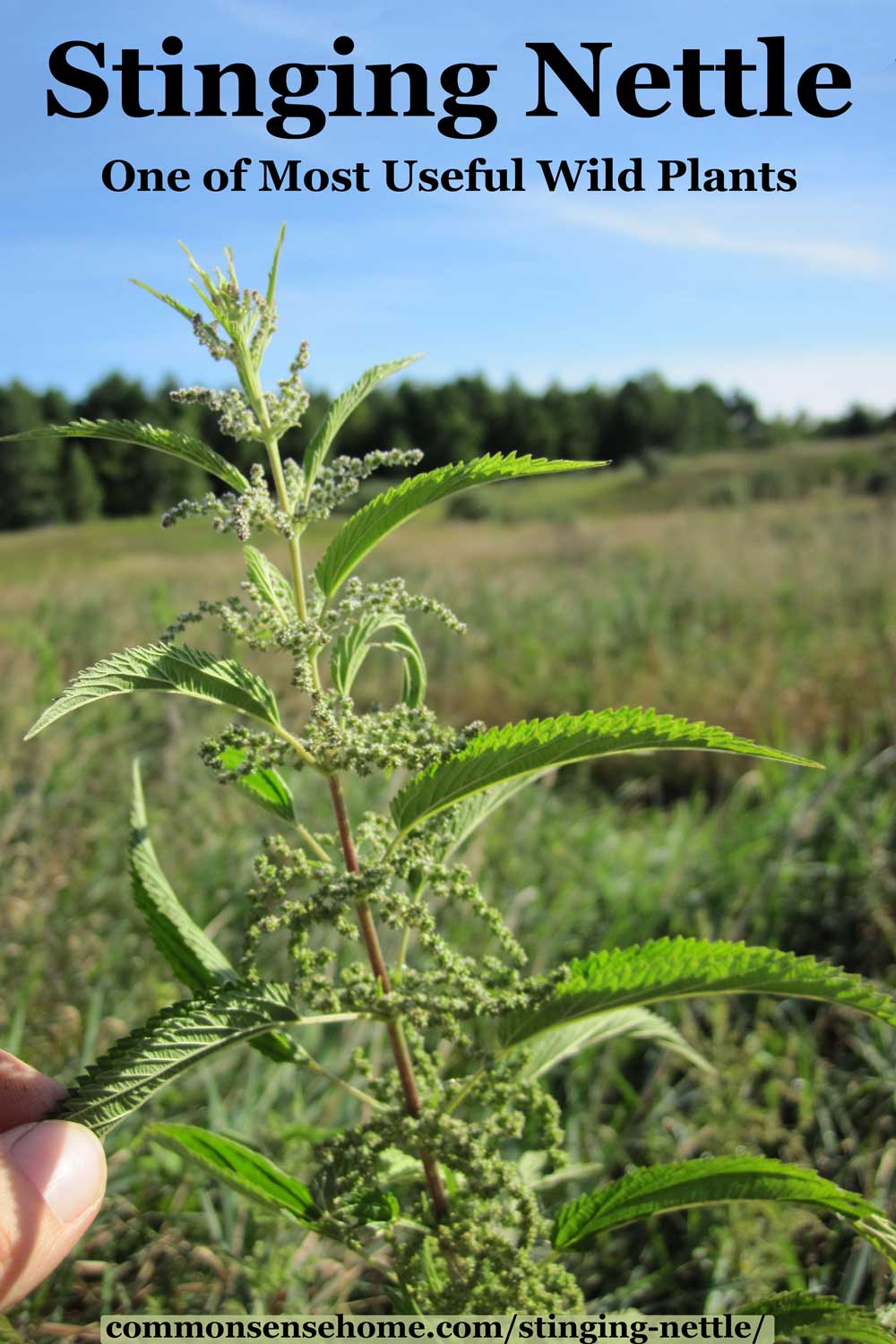
Other potential health benefits include:
- Stopping bleeding
- Antiseptic
- Poultice with drawing action for external ulcers
- Fresh juice used as toothache cure
- Infused ointment for insect bites and stings, rashes, burns, hives and fungal infections. (The “sting” contains histamines, the juice contains antihistamines.)
- Seeds act as a thyroid tonic and poison antidote
- Endocrine gland tonic
- Respiratory strengthener
- Improve digestive health
- Boost energy
- Act as a gentle laxative
- Improve lactation
Nettle Tea
Cover a tablespoon of dried leaf or crushed fresh leaves with a cup of boiling water. Let steep for 15 to 20 minutes, strain and drink. Sweeten with a bit of honey or maple syrup, if desired.
The tea can also be used as a hair rinse or massaged into the scalp to promote hair growth. For acne or other skin conditions, dab cooled tea onto the affected area.
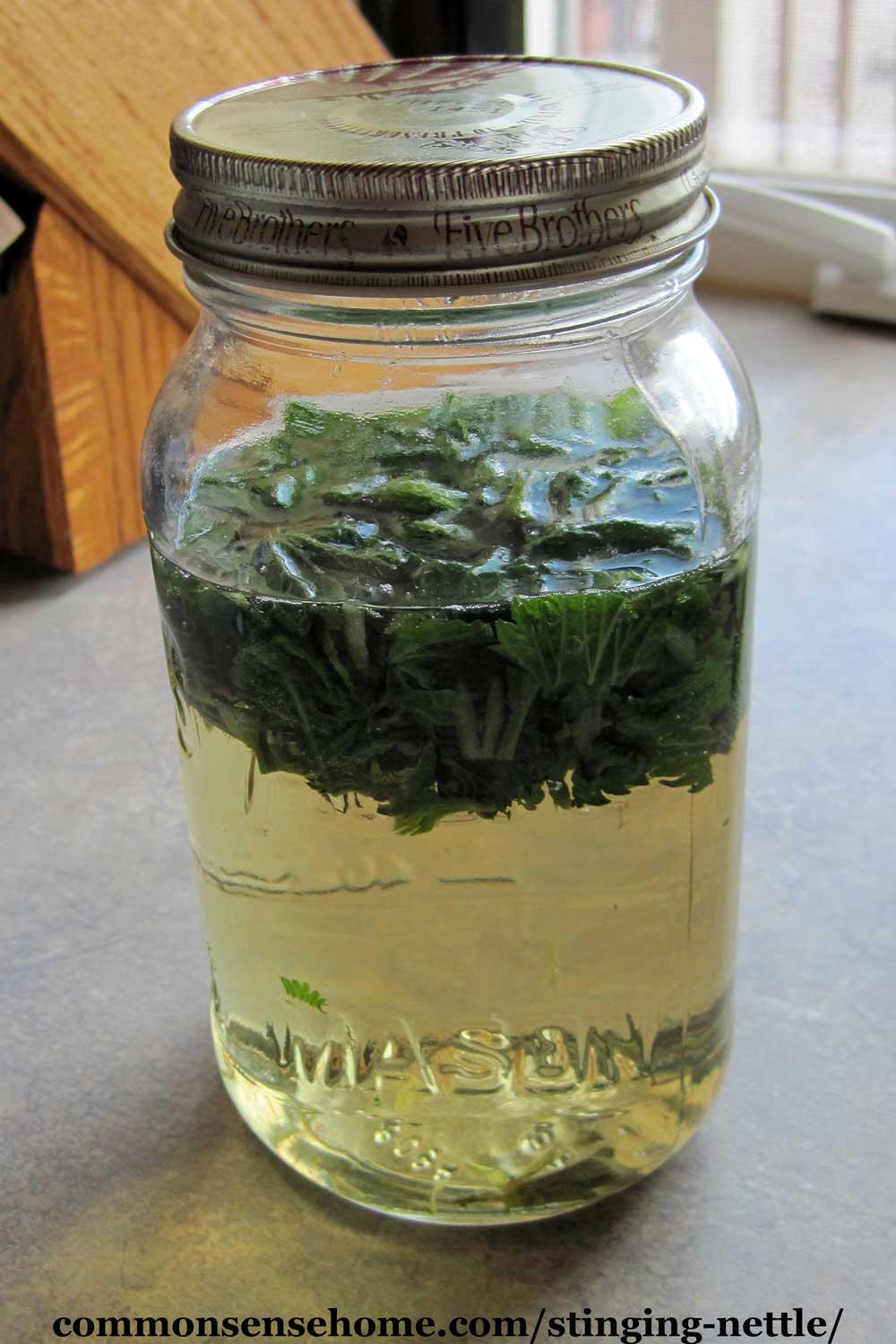
Nettle Infusion (Like an Extra Strong Tea)
To make an infusion, simply pour one cup boiling water over one ounce dried chopped leaves (by weight), cover and steep 4 hours or overnight. Strain out plant material and drink. Refrigerate any leftovers and consume within 48 hours.
The books Backyard Medicine and Healing Wise have a wonderfully detailed information on making and using nettle remedies.
Side Effects of Nettles
Always consult your health care provider if you are on any medications, nursing or pregnant.
Nettle may enhance the effect diuretic medications, and also increase excretion of lithium and other anti-depressant medications.
In the video below I show off our patch in spring.
Use Nettle in the Garden
Loaded with nutrients, nettle tea makes a great plant food. You can also add nettle leaves to your compost pile for some extra “oomph”.
Working with Nettle Fibers
I asked Jay Soni, founder of Yorkshire Fabric Shop, “In your experience, how does working with stinging nettle fibers compare to working with flax fibers? Can you use a spinning wheel to make stinging nettle fibers into twine?” His reply:
From my experience, working with stinging nettle fibers versus flax fibers is like night and day because each plant’s fibers are so different. Stinging nettle fibers are shorter and rougher, so you have to put in more effort to prep them. This means doing a lot of retting and softening to get rid of the tough outer layers.
Flax fibers are naturally longer and smoother, which makes them a breeze to turn into fine yarns or fabrics, and you generally end up with a smoother finished product with a lot less hassle.
But stinging nettle has its perks-its durability and unique texture make it great for projects where you need something strong and with a natural, earthy vibe. And yes, you can definitely use a spinning wheel to make twine out of stinging nettle fibers, but it’s not as straightforward as with flax.
Because nettle fibers are shorter and more inconsistent, you really need to focus on getting the fibers lined up right to get a good spin. You might need to tweak the spinning wheel’s tension to handle the rougher texture without snapping the fibers. Going slow helps a lot too, as it lets you manage the twist and keeps everything aligned properly.
While flax might slide through the wheel smoothly, nettle needs more hands-on attention to turn into twine. But the extra effort pays off because you get this super strong twine with a rustic charm, perfect for making things like ropes, mats, or even decorative pieces where you want a bit of rugged texture and toughness.
Learn to Use Your Weeds
This post is part of the Weekly Weeder series, which is devoted to helping you use and manage wild plants.
Other posts in the series include:
- Recommended Wildcrafting Reference Books – Weekly Weeder #1
- Chickweed – Herbal Remedy for Itchy and Inflamed Skin – Weekly Weeder #2
- Benefits of Dandelion Plus How to Use Greens, Seeds, Roots & Flowers – Weekly Weeder #17
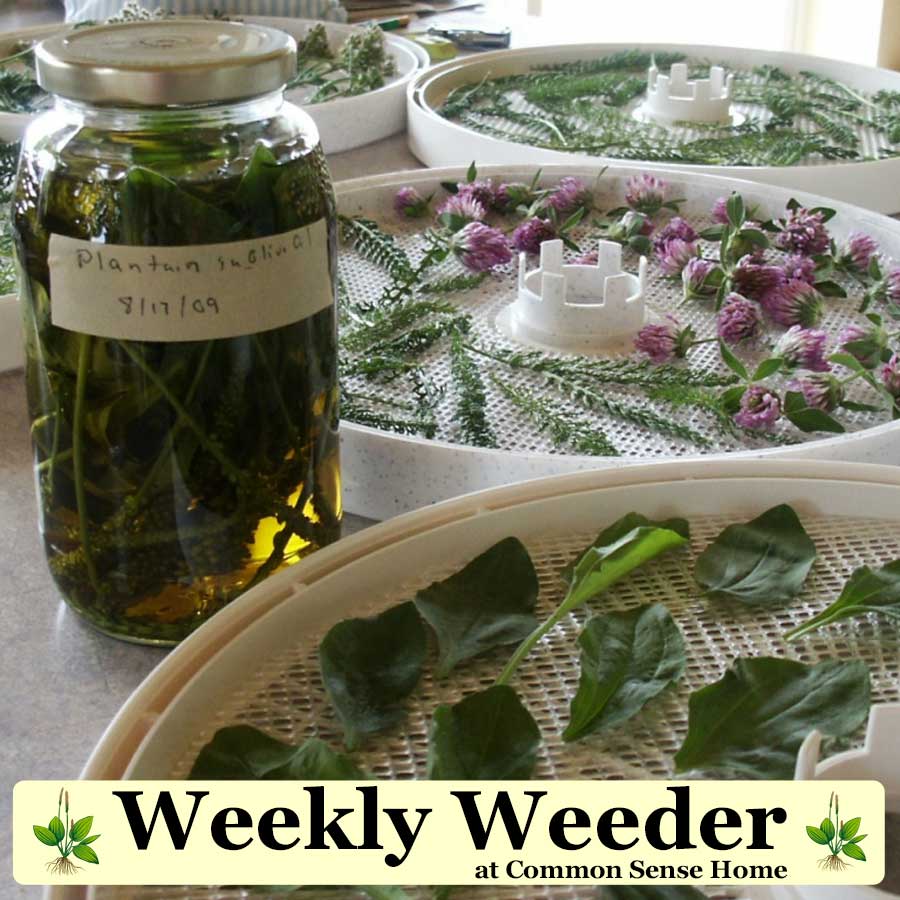
References
- Efficacy of Supportive Therapy of Allergic Rhinitis by Stinging Nettle (Urtica dioica) root extract: a Randomized, Double-Blind, Placebo- Controlled, Clinical Trial
- The Efficacy of Stinging Nettle (Urtica Dioica) in Patients with Benign Prostatic Hyperplasia: A Randomized Double-Blind Study in 100 Patients
- Dietary Plants for the Prevention and Management of Kidney Stones: Preclinical and Clinical Evidence and Molecular Mechanisms
- Improved glycemic control in patients with advanced type 2 diabetes mellitus taking Urtica dioica leaf extract: a randomized double-blind placebo-controlled clinical trial.
Originally posted in 2012, updated in 2019.

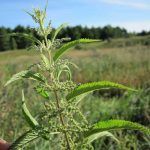
Hello,
I have a great abundance of nettle in my garden & I regularly make a green juice with it and apples.
When you say not to consume it raw, is that because of the stings? I’ve always heard that it is an important histamine reducer & as I am currently having symptoms with my skin, I’m drinking it everyday to get down the itch.
Going from one to four juices a day, has made a big difference. I tend to do two of those with nettle.
I’ve seen a few people make comments about deliberately stinging oneself to force the body to lower its histamine load too, have you heard of this?
Thank you!
Kylie
Some people have a reaction to the raw juice, which can produce a burning sensation in the mouth and throat. (I’m one of those people.) That’s why I don’t recommend consuming it raw. If you can tolerate it, it should be okay for you.
I’ve seen people thrash themselves with stinging nettle for arthritis pain. It is a natural antihistamine, so I could see where self-flagellating with nettle could also be an effective treatment to reduce histamine load in lieu of taking it internally.
When I was young my grandmother would may a little mud from the garden and put it on our nettle and bee stings. It always worked like a charm in minor cases and I still use it. It calmed down the itchy burn and is great for immediate relief. Only temporary or mild relief for worse exposure but allows for quick/minor relief in an outing when nothing else available.
I didn’t know about applying juices from the leaf. Thank you for the great information.
You’re welcome. Thanks for sharing your mud remedy. I’ve used mud before, too, and saliva, when I don’t have other options on hand.
Enjoyed this so much! I’m new to herbs and haven’t experienced this one yet but I use two others that might be relevant. Mimosa and goldenrod are both blamed for seasonal allergies in this area and I have been using both successfully as a tincture to treat allergies and allergic reactions. If I apply one of these promptly after a fire ant sting, I don’t end up with my usual, tiny, itching pustule at each sting. You might find that one of them is effective for stinging nettle stings too.
That’s interesting. We don’t have mimosa around here (except as a houseplant), but we do have goldenrod.
In reference to the itching side affects I have my own home remedy that I use for poison ivy. My research tells me that the wound itches when in contact with oxygen. The resulting scratching from the itching spreads the toxin. A simple flour and water paste can relieve both symptoms. It blocks the oxygen from getting to the wound and as the paste dries it absorbs the toxin. Doesn’t that sound logical? I’ve experienced complete recovery overnight.
That is quite interesting. Thank you for sharing.
Just went on a Wild Food Forage Walk with a guide at a local park and we harvested 1 root each fom a couple of Stinging Nettle plants and then replanted. After the walk, we chopped them like carrots and fried them. They tasted just like fried potatoes. With this article, this is my new “favorite” plant to work with! Thank you so much.
You’re welcome. They do like good soil with plenty of nitrogen, so top dressing with compost, aged manure, or old animal bedding will help keep your patch vigorous.
Yes, I would like to thank you so much for your time and effort to bring our attention to important ‘weeds’; I’m learning that most of the weeds in our area are very beneficial; never realized till I started looking into it; the crazy thing is, my daughter was visiting this past week and brought a book she had pick up, the wise woman book on herbs; I didn’t get much of a chance to look through it, but glad my daughter is interested and starting at a younger age then I did; she may end up wiser then her momma at some point, lol; again thank you, to you and your family, for investing your time and energy to bring us good and useful information; it’s always good to see families working together; I always look forward to your next post!
Thank you for your kindness, Barbara.
I’ve found learning about weeds to be very enlightening in many ways. Instead of looking at them like adversaries now, I look at them as old friends who’ve popped up to tell me something, or because I need them. The soil talks through the weeds, as the seeds can lay dormant for decades, but spring to life only when condition are right.
You mentioned the Wise Woman book on herbs – by chance is that one of Susun Weed’s books? She’s got a whimsical style, but you can tell that she really connects with the plants.
Laurie, THANK YOU kindly for all the information and the links that are so helpful. I truly appreciate you taking the time to write this.
Thank you for your kindness.
I am on a low oxalate diet due to passing a kidney stone. I was told to stop drinking my stinging nettle infusion that I had been drinking on and off for over a year for some of it’s beneficial properties.
Your article mentions that it is good at dissolving oxalates. Can you provide any research to back up this claim. I never want to experience a kidney stone again and am eager to start consuming stinging nettle tea for it’s many benefits again.
Thank you for any information you can provide and thank you for sharing your knowledge with all of us.
The references are listed at the bottom of the post.
In this case, the relevant study is “Dietary Plants for the Prevention and Management of Kidney Stones: Preclinical and Clinical Evidence and Molecular Mechanisms“.
The relevant paragraph is as follows (emphasis mine):
I got here from a link on pinterest. The only reason i came here was that the photo is NOT a stinging nettle. It kinda drives it home that someone is holding the leaves between their fingers! You may want to change that as it puts into question your credibility.
You might want to stop randomly being rude to people on the internet, because you don’t know what you’re talking about.
The plant I am holding in the photo is most assuredly stinging nettle. I grew up with it, we have it all over, and if I had wrapped my hand tightly around the base of the leaf or the stem I would have been dealing with a stinging hand. BUT – new tender growth, like leaf tips, can be handled – carefully – without getting stung. This is why I’m only holding the leaf tip.
My hands are also fairly tough from working out in the garden. My mom used to cut and chop the ones she fed to the flock with bare hands. If you stick to the young growth, they sting less, but she was tougher than I am.
Work with your plants and get to know them better.
It is nettle. The thick part of skin such as finger prints will not be afected so if you are careful you can pick it with your fingertips. And the young leaves do not have the ability to sting so you can harvest the top 2-3 inches without problem.
You can make a wonderful green pasta with nettle leaves:
https://www.wildedible.com/blog/handmade-nettle-pasta
Do Not eat old leaves! Not good for you!
Old leaves are not good for eating, but can still be used for tea.
Great article, Laurie! I use the seeds to restore kidney function. The fibers in the plant are used to make cloth. I love this plant! I grow it on the perimeter of our yard to help ward off unwelcomed guests…lol.
Thanks for sharing your experience, BJ. There are so many historical uses of this plant that it was hard to pick just a handful to keep the article from getting crazy long, so I hope more people chime in with their experience.
We find that nettle tea works very well for seasonal allergies. We use it as a tea. I don’t mind the flavor plain.
Thanks for this well-researched post. I enjoy learning about weeds and wild edibles.
I was harvesting wild greens for my rabbits when I felt a prick and some burning. I didn’t know what had stung me, but closer inspection revealed young nettle plants at the edge of my garden. I was pretty excited to find it, but boy that sting was something else! I went to bed with it still throbbing, but woke up to see it had worn off. I had it in my head that a poultice of nettle leaves soothes arthritis. Have you heard of this?
I haven’t personally tried it, but nettles are commonly used for arthritis treatment externally and internally. The poultice option may work well for those who are not up to beating themselves with the plant.
What a great article and video! Thanks so much–I love your explanations and how you kept the camera on the plant for so long. It really helped me in terms of what nettles look like. I’m currently reading Susan Weed’s Healing Wise and nettle is my first herbal ally! Thanks again!
You’re welcome. I hope you enjoy other posts in the series as well. I’m slowly working through them, adding more information and larger photos. Blogging has changed quite a bit over the years.
Around here nettles are most often encountered along streams and other damp places. Fortunately it is also the home of Jewelweed. In fact they are frequently growing side-by-side! This is very convenient as the sap from the crushed stems of jewelweed IMMEDIATELY soothes the sting of stinging nettles. It’s also good for other skin irritations, including poison ivy and bee stings. Jewelweed, learn to identify it. It truly is a jewel!
More on jewelweed in Weekly Weeder #33 – https://commonsensehome.com/jewelweed/
I was skeptical for years until I tried it and it works.
I have read about using the fiber in the stalk to be a good for making yarn. Do you have a source for that?
My friend, Chris, has a series on harvesting and using nettles for spinning and weaving that starts with this article – https://joybileefarm.com/harvesting-nettles-for-spinning-and-weaving/
Nettle is so neat. I’ve been meaning to try tea and various soup recipes… It makes real neat twine too.
I know that it’s tough. The canes are always standing come springtime.
Greetings!
My name is Clayton Wangbichler. I work for Mountain Bike Action Magazine. I’ve written a story, regarding pretty plants on the trail that leave a bit of a bite. Living in the desert of Southern California, I don’t have the ability to photograph these plants. Would you be willing to grant me permission to use the top stinging nettle photo above?
Thank you,
Clayton
The photo may be used with credit and a link back to the site.
– Laurie
Hi, Laurie. You’ve inspired me to gather nettles! I have lots. I was wondering how long you dried yours and at what temperature. (I also have an Excalibur.) Thank you!
Hi Sarah! I dry them at low temp (herb setting) until crisp, around a day or so.
It says “To make a nettle infusion, simply pour boiling water over one ounce fresh or dried chopped leaves (by weight)” … is this correct? As we all know, an ounce of fresh is a lot less than an ounce of dried, wouldn’t the dried be super strong, or the fresh be super weak? Isn’t it like herbs, where you divide by about 4 fresh to 1 dry?
Lora – yes, you are right. It really doesn’t matter too much if an infusion is much stronger, but in this case the dried herb is much less likely to provoke a reaction. With other herbs, I generally just chop and go, so I gave the measurement as a rough guideline.
Nettle looks like a lot of the weeds that grow around here, and this being the worst allergy year I’ve had in a while, I thought, allergy remedy, I can try that! But the itching sensation you mention makes me worry that maybe that’s one of the things I’m allergic to. When I walk through a wild field if I’m barefoot or in shorts I break out in awful, itchy rashes. I know specifically some grasses get me, but what, if anything else, I’m not sure of. So to be safe I think I shall steer clear. 😉
That being said, having just recently discovered Nourishing Traditions, the GAPS diet, Deep Nutrition, etc. type nutritional recommendations after years of being a vegetarian, I’m trying to incorporate more of the whole fats, probiotics, organ meats, etc. in my diet and cut back on grains. I’m a gradual change kinda gal, so maybe it won’t do so much for this season’s allergies, but here’s hoping I get things ironed out so I’m not so miserable and sneezy and stuffy next year! 🙂
Nettles do produce a stinging sensation when you touch them. I would not walk bare legged through a field of nettles, unless perhaps I was trying to treat joint pain in my legs. Some people flagellate joints afflicted with gout type symptoms with nettle, as the stinging is supposed to refocus the pain away from the gout pain somehow. I have not tried this. If you do try the nettles, make sure to cook thoroughly, and try only a small amount.
If you simmer the fresh leaves for a minimum of 10 minutes you will eliminate the stinging properties. Then you can eat the leaves and resulting broth/tea.
Thanks, Janet.
I tend to saute my nettle in just a tiny bit of oil – I’ve wondered, though, if steaming would get rid of the itch, as it would certainly retain more nutrients. What do you think?
Phil – only one way to find out for sure. Each person reacts to things a little differently. All Susun’s recipes call for greens to be well cooked, and after my experience yesterday, I think I’ll stick with well cooked. My mouth still feels a little funny. I have been eying up the nettle beer recipe….